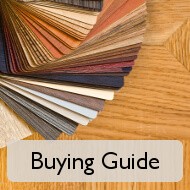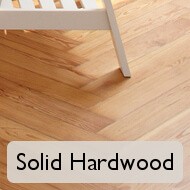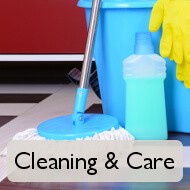Solid Hardwood Flooring Buying Guide
 Solid hardwood flooring gives a home character and beauty that is unsurpassed by other types of flooring. Hardwood floors are visually appealing and make any home feel comfortable and inviting. You’ve got an impressive variety of styles, widths and finishes from which to choose, so you’ll find just the right one to set the tone for your home’s décor.
Solid hardwood flooring gives a home character and beauty that is unsurpassed by other types of flooring. Hardwood floors are visually appealing and make any home feel comfortable and inviting. You’ve got an impressive variety of styles, widths and finishes from which to choose, so you’ll find just the right one to set the tone for your home’s décor.
Hardwood floors add to the value of your home wherever they are installed. Their return on investment is one of the best in the flooring industry. They truly are an investment in a home, not just an expense. The appeal to homeowners is that hardwood floors work well in traditional homes and contemporary homes alike, with flooring options to fit any design scheme. Widths as narrow as 2 ¼” and wider than 6” are available in the finish of your choice.
Ultimately, If you’re in the market for authentic beauty that is available in hundreds of combinations of style and finish, solid hardwood flooring is a wonderful choice. It brings warmth, quality and natural beauty wherever it is used.
Use this guide to hardwood flooring to learn about what makes this type of home flooring so popular. We’ll share information about durability, the various styles and material used in solid hardwood flooring, as well as the current trends in the market. We also encourage you to read our other detailed guides on solid hardwood floor prices, installation, and of course the care and maintenance of hardwood flooring.
Wear and Durability
Hardwood flooring is made from a single piece of wood and therefore very durable. Today, there are plenty of wood floors that are still in use more than 100 years after they were first laid. If the floor is maintained properly, home flooring pros estimate it will last anywhere from 75 to 100 years. Refinishing is required every 8-20 years depending on how heavy the traffic (footfall) is in your home. Applying a fresh coat of sealant/protector in-between refinishes can extend the time before refinishing is required again.
These floors are quite tough and scratch-resistant, though they can be marred by heavy, sharp objects. Using a good top-coat when finishing the floor will go a long way toward reducing scratches and staining from water or other substances.
Materials, Lengths and Patterns
The most common solid wood flooring species are white oak and red oak, maple, walnut, ash, hickory, beech, yellow birch, mahogany and pine. Oak is one of the harder and more durable options while pine is the softest and is used in homes but rarely in commercial buildings. Some manufacturers are using more exotic woods such as sakura and kempas.
The width of the hardwood floor planks varies from 2 ¼” to 6”, and custom planks can be milled that are even wider. As a rule of thumb, narrower widths produce a more contemporary or formal appearance; wider widths are used where a traditional, colonial, old world or country style is desired.
Planks can be as long as 12’ and as short as 24”. When you purchase hardwood flooring, you typically receive pieces cut to differing lengths in order to make it easier to blend pieces. This gives the floor the random look you want.
You’ve got a choice between unfinished hardwood flooring or pre-finished planks. The pre-finished planks come in dozens of styles and finishes, so you’ll have no trouble finding just the right width, look and shade for your installation. If you enjoy DIY projects and plan to finish the floors yourself , you’ve again got almost unlimited options from natural or bleached to very dark woods.
Leading Brands and Current Trends
While hardwood floors never went completely out of fashion, they are certainly enjoying a resurgence. There are certainly a host of flooring manufacturers and styles from which to chose.
The leading brands in the industry have been around for decades. These include Armstrong, Bruce, Harris, Bellawood, Lauzon, Goodfellow, Bamtex, Kahrs, Mannington, Muskoka, Mohawk, Robbins, Aspen Hills and Westhollow.
Check out our hardwood flooring reviews
Overview of the top trends in solid hardwood flooring.
- Authentic Styling: In a fast-paced world, homeowners are looking for design elements in their home that are timeless, brought from an era where life was slower and more relaxed.
- Hand Scraped Hardwood: Sometimes referred to as handscraped, it comes in many styles and harks back to the days when each plank was worked by hand. Planks are often milled with the appearance of age and some wear. Distressed wood flooring is very similar. It has the look of reclaimed wood.
- Wider Wood Planks: The overall trend in wood is obvious. People are longing for a return to simpler times and old-fashioned charm with wider planks and reclaimed wood both increasing in popularity.
- Exotic Woods: Each year, new exotic woods are introduced. Currently, sakura, kempas, Brazilian cherrywood, tigerwood and teak are among the most popular.
Once you have an idea of which hardwood you would like then hop on over to this article to discover the best places to buy hardwood floors.
Solid Hardwood Flooring FAQs
Q: What are the advantages of solid hardwood flooring?
A: Solid floors are very durable and can be refinished 6-8 times over their life. This is not the case with engineered wood. In addition, solid hardwood is beautiful, better for the environment than carpeting, is easy to care for and clean and doesn’t harbor allergens in the same way as carpet does.
Q: Can hardwood floors be glued to concrete?
A: No. Solid wood expands and contracts with changes in humidity and temperature. Gluing it to any surface will lead to cracking and other issues. It should not be used over concrete unless it is a floating wood floor or there is a subfloor beneath it.
Q: Can hardwood flooring be used in a basement?
A: Any level of a home that is below grade will probably have more moisture near the floor than is good for wood flooring. The wood can absorb the moisture and buckle. Engineered wood is a better choice for basement flooring.
Q: Can solid wood flooring be used over radiant floor heating?
A: Yes it can, but a subfloor must be used. When nailing down the floor, be careful of the underlying water lines if they are exposed. Home flooring pros recommend installation of quartersawn hardwood over radiant heat systems.





